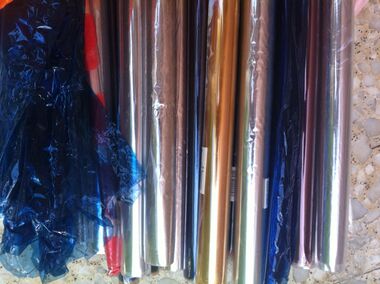سيلوفان
السيلوفان أو السلوفان Cellophane هي رقائق رفيعة وشفافة تصنع من مادة السليلوز المعاد توليده. وعادة ما تستخدم في التغليف. Its low permeability to air, oils, greases, bacteria, and liquid water makes it useful for food packaging. Cellophane is highly permeable to water vapour, but may be coated with nitrocellulose lacquer to prevent this.
Cellophane is also used in transparent pressure-sensitive tape, tubing and many other similar applications.
Cellophane is compostable and biodegradable, and can be obtained from biomaterials.[1] Production, however, uses carbon disulfide (CS2), which has been found to be highly toxic to workers.[2] The lyocell process, however, can be used to produce cellulose film without involving carbon disulfide.[3]
"Cellophane" is a generic term in some countries,[4] while in other countries it is a registered trademark.
الانتاج
Cellulose from wood, cotton, hemp, or other sources is dissolved in alkali and carbon disulfide to make a solution called viscose, which is then extruded through a slit into a bath of dilute sulfuric acid and sodium sulfate to reconvert the viscose into cellulose. The film is then passed through several more baths, one to remove sulfur, one to bleach the film, and one to add softening materials such as glycerin to prevent the film from becoming brittle.
A similar process, using a hole (a spinneret) instead of a slit, is used to make a fibre called rayon. Chemically, cellophane, rayon and cellulose are polymers of glucose; they differ structurally rather than chemically.
التاريخ

Cellophane was invented by Swiss chemist Jacques E. Brandenberger while employed by Blanchisserie et Teinturerie de Thaon.[6] In 1900, inspired by seeing wine spill on a restaurant's tablecloth, he decided to create a cloth that could repel liquids rather than absorb them. His first step was to spray a waterproof coating onto fabric, and he opted to try viscose. The resultant coated fabric was far too stiff, but the diaphanous film coating could be separated from the backing cloth easily and in one undamaged piece. Seeing the possibilities of this new material on its own, Brandenberger soon abandoned his original idea.
It took ten years for Brandenberger to perfect his film. His chief improvement over earlier work with such films was adding glycerin to soften the material. By 1912 he had constructed a machine to manufacture the film, which he had named Cellophane, from the words cellulose and diaphane ("transparent"). Cellophane was patented that year.[7] The following year, the company Comptoir des Textiles Artificiels (CTA) bought the Thaon firm's interest in Cellophane and established Brandenberger in a new company, La Cellophane SA.[8]
Whitman's candy company initiated use of cellophane for candy wrapping in the United States in 1912 for their Whitman's Sampler. They remained the largest user of imported cellophane from France until nearly 1924, when DuPont built the first cellophane manufacturing plant in the US. Cellophane saw limited sales in the US at first since while it was waterproof, it was not moisture proof—it held or repelled water but was permeable to water vapor. This meant that it was unsuited to packaging products that required moisture proofing. DuPont hired chemist William Hale Charch (1898–1958), who spent three years developing a nitrocellulose lacquer that, when applied to Cellophane, made it moisture proof.[9] Following the introduction of moisture-proof Cellophane in 1927, the material's sales tripled between 1928 and 1930, and in 1938, Cellophane accounted for 10% of DuPont's sales and 25% of its profits.[8]
انظر أيضاً
المراجع
- ^ Morris, Barry A. (2017). "Commonly Used Resins and Substrates in Flexible Packaging". In William, Andrew (ed.). The Science and Technology of Flexible Packaging: Multilayer Films from Resin and Process to End Use. Vol. Plastics Design Library. doi:10.1016/C2013-0-00506-3. ISBN 978-0-323-24273-8. Retrieved 2021-05-05.
Cellophane is biosourced, compostable, and biodegradable.
{{cite book}}:|work=ignored (help) - ^ Swan, Norman; Blanc, Paul (20 February 2017). "The health burden of viscose rayon". ABC Radio National (in الإنجليزية).
- ^ "Cellulose Sausage Skins via the Lyocell Process". AZO Materials. 2002-08-27. Retrieved 2022-07-02.
- ^ "Has cellophane become a generic trademark?". genericides.org. Retrieved April 29, 2021.
- ^ Krässig, Hans; Schurz, Josef; Steadman, Robert G.; Schliefer, Karl; Albrecht, Wilhelm; Mohring, Marc; Schlosser, Harald (2002). "Cellulose". Ullmann's Encyclopedia of Industrial Chemistry. Weinheim: Wiley-VCH. doi:10.1002/14356007.a05_375.pub2.
{{cite encyclopedia}}: Cite has empty unknown parameter:|authors=(help) - ^ Carraher, Charles E. (Jr.) (2014). Carraher's Polymer Chemistry: Ninth Edition. Boca Raton Fl.: CRC Press, Taylor & Francis Group. p. 301. ISBN 978-1-4665-5203-6.
- ^ Carlisle, Rodney (2004). Scientific American Inventions and Discoveries, p.338. John Wiley & Sons, Inc., New Jersey. ISBN 0-471-24410-4.
- ^ أ ب Hounshell, David A.; John Kenly Smith (1988). Science and Corporate Strategy: Du Pont R&D, 1902–1980. Cambridge University Press. p. 170. ISBN 0-521-32767-9.
- ^ Winkler, John K. (1935). The Dupont Dynasty. Baltimore, MD: Waverly Press, Inc. p. 271.
وصلات خارجية
- Blanc, Paul David (2016). Fake silk : the lethal history of viscose rayon. New Haven: Yale University Press. p. 328. ISBN 9780300204667.
- Cellophane Invention
